Character Counts
2020 in Review: A look back at UofSC highlights
Posted on: December 18, 2020; Updated on: December 18, 2020
It’s been a year. Full stop.
But that doesn’t mean there wasn’t plenty to celebrate, recognize and honor at the University of South Carolina in 2020. There was. And there’s even more to look forward to in 2021.
Whether we were developing innovative instruction strategies and aggressive testing protocols to confront the coronavirus, whether we were making our voices heard on social justice issues or proving our mettle, yet again, on campus and in the community, UofSC rose to each and every challenge this year and raised the bar for the year to come.
We welcomed new leadership, including provost and executive vice president for academic affairs William Tate; vice president for diversity, equity and inclusion Julian Williams; law school dean William Hubbard; and vice president for communications Larry Thomas.
We also announced a new vice president for development, Monica Delisa, who will begin in January 2021, and a new head football coach, Shane Beamer, who will lead the Gamecocks onto the field at Williams-Brice next fall.
And we adjusted to the new normal. We taught courses, conducted research and pursued scholarship at a time when it might have been easier to wait and see. We opened new classrooms, offices and labs. We built new partnerships and strengthened existing ones. We played sports, and we cheered.
Of course, we had good reason, and not just on the field. Check out the rankings: best public university first-year experience, best international business programs (graduate and undergraduate), four Top 5 and twelve Top 25 graduate programs, all according to U.S. News & World Report. In all, we now boast 56 nationally ranked academic programs, more than any other university in the state.
Meanwhile, Inside Honors named the South Carolina Honors College tops among public honors colleges nationwide, the Global Ranking of Sport Science Schools and Departments ranked the university’s sports sciences programs No. 1 in the U.S. for the fourth year running, and the Department of Defense recognized our Navy ROTC program, which turned 80 in 2020, as the best in the nation.
No surprise, we’re one of the fastest-growing flagship universities in the country. At the Columbia campus alone, we minted 7,288 new graduates in the spring and opened our doors to 7,750 new students in the fall. To prepare for the next chapter, we also unveiled a bold new strategic plan, which will guide the university’s growth and improvement in the years to come.
Most importantly, though, we showed what we’re made of, who we are and what we can become. Challenge is opportunity waiting to happen, but it also reveals character. And in 2020, our character was our greatest strength.
“When the University of South Carolina’s COVID-19 story is written, I believe we will read a narrative of resilience, determination and compassion. We will read about a ‘team of teams’ that guided us through the challenges and hardships of a global pandemic. We will read about students who adapted to new ways of learning, and faculty and staff who made those new ways possible. We will read about a culture of caring.”
President Bob Caslen, letter to alumni, Carolinian, winter 2020
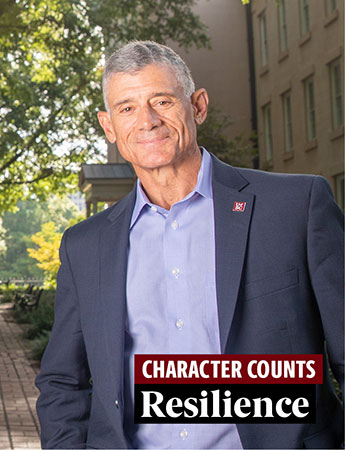
COVID-19: Up to the test
When the first wave of the COVID-19 pandemic hit earlier this year, it was all-hands-on-deck at the University of South Carolina, where faculty and staff members, students and alumni responded in bold fashion.
Following spring break, professors moved classroom instruction online for the remainder of the spring semester, and President Caslen held the first of what would become a regular offering of virtual town hall meetings, reaching out to students, parents, faculty and staff to keep them abreast of the university’s plans. The town hall meetings demonstrated Caslen’s ongoing commitment to clear communication in a time of crisis and his concern for the well-being of the campus community.
Student leaders stepped up, too. Student Government President Issy Rushton led efforts to launch I Pledge Columbia, which encourages Carolina students to adhere to best practices in COVID-19 hygiene and physical distancing to help keep Columbia safe for everyone.
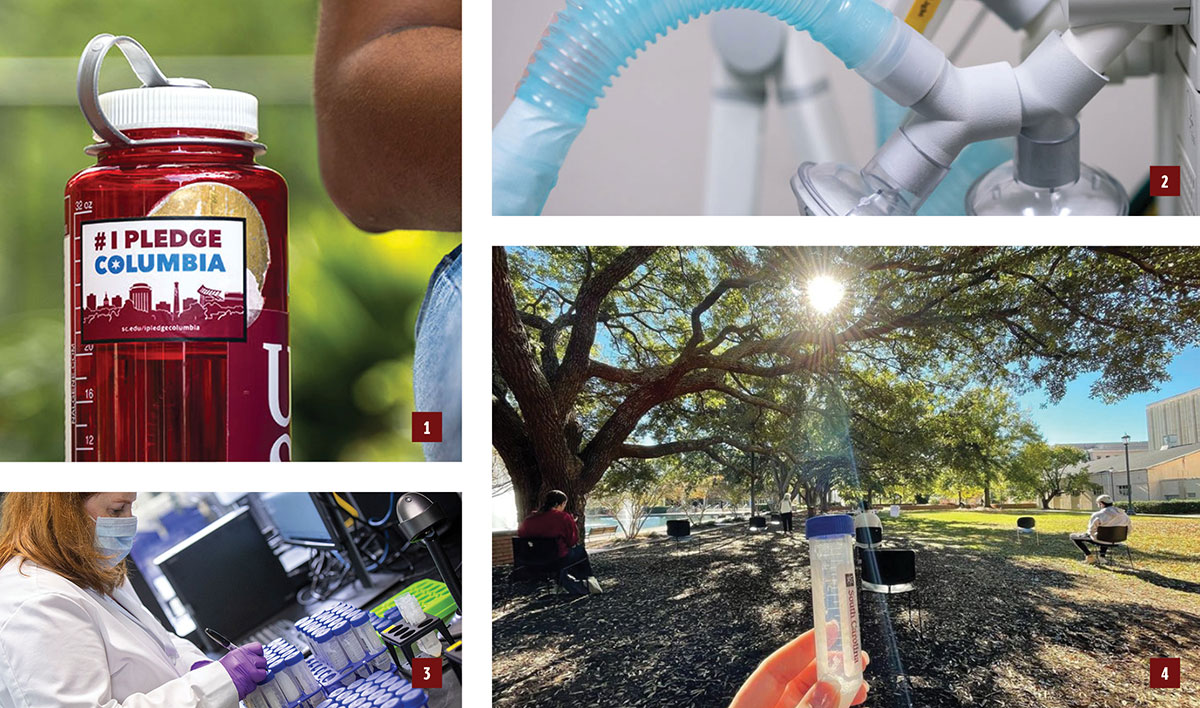
Of course, safely reopening campus in the fall also meant rapid and accurate testing. To meet that need, scientists in the College of Pharmacy collaborated with colleagues across the country to develop a simple saliva test for COVID-19 that could yield results in 24 hours or less. Meanwhile, Arnold School of Public Health scientists developed a means of rapidly testing raw sewage to determine the population health of a community, a technique that has been shared across the state.
And that innovative spirit spread throughout the university system. One of the earliest examples came from the School of Medicine Greenville, which partnered with Prisma Health and the College of Engineering and Computing to get emergency FDA approval for a device that allows a single ventilator to assist up to four patients at once. The idea went from concept to reality in just two weeks. A subsequent partnership with a subsidiary of Johnson & Johnson allowed the device to be manufactured and distributed at no cost to U.S. health care providers.
And let’s not forget our PPE. Faculty and students didn’t simply mask up this year. When high demand created a temporary shortage of personal protective equipment for health care workers in South Carolina, engineering students worked with faculty members to create 3D-printed face shields to help address the need.
But technology alone can’t beat COVID-19. The world also needs front line health care workers with the skill, dedication and courage to confront the pandemic head on, and this spring our College of Nursing alumni could have put on a clinic. As the first wave of the virus hit New York City, several of them volunteered at some of the city’s hardest hit hospitals. “My heart seriously broke for the nurses, how much they were struggling,” says Rosina Fadul, ’15 BSN. “I realized, ‘I have the ability to make a difference, to help take off some of the burden.’”
“It is an honor to be selected to lead inclusion and diversity efforts at South Carolina’s flagship institution. My goal is to bring to the forefront a community-developed vision for inclusion and diversity ensuring that all members of the USC community are able to bring their authentic selves to campus every day. I will work to build strong relationships based upon trust, transparency, and honesty in order to move this vital work forward.”
Julian Williams, vice president for diversity, equity and inclusion, as-told-to @UofSC Today
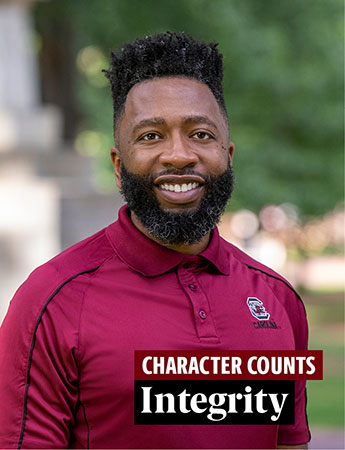
Social justice for all
Fifty years ago, in May 1970, the University of South Carolina made national headlines as students demonstrated against the war in Vietnam, gender and racial inequality and a university administration that they felt was out of step with their generation. And while the story of Vietnam-era student activism recounted by alumni in the summer issue of Carolinian magazine was complicated, in some respects even problematic, it ushered in positive developments. In addition to raising consciousness among many members of the student body, some of whom made social justice and activism their life’s mission, the unrest of 1970 gave rise to the University 101 program, which in 2020 remains the undisputed national model for first-year experience programs.
But make no mistake, UofSC in 2020 is not the USC of 1970. In fact, when it comes to pressing societal issues such as diversity and inclusion, it’s not even the UofSC of 2019.
Just look at the numbers. Underrepresented minorities now make up 25 percent of the 7,750 new students who came to UofSC this fall. Eighteen percent of new freshmen are first-generation college students. Since 2016, African American freshman enrollment has grown 28 percent and Hispanic enrollment has grown by 55 percent.
“I’m thrilled and honored to greet this extraordinary class of first-time students to campus and to Columbia,” President Caslen said upon seeing the latest stats. “The diversity and academic talent represented in this new group of students will make us even stronger, and I look forward to seeing these students become an integral part of our Gamecock community.”
The university’s ongoing efforts are also reflected in the One Creed, One Carolina fundraising campaign, which highlights programs and projects that directly impact Black students on campus, and in bold new initiatives and new hires. As of Dec. 1, this campaign has raised $29,789 for 26 different programs, projects or scholarships that impact Black students at UofSC.
And it’s not just a numbers game. The Presidential Commission on University History was established late in 2019, but its work began in earnest in 2020. The commission is tasked with exploring the controversial histories of people whose names grace certain campus buildings, including the Sims residence hall on the Women’s Quad, the Strom Thurmond Wellness and Fitness Center and Thomas Cooper Library. The university meanwhile reaffirmed its commitment to diversity and inclusion among faculty, staff and students, naming its first vice president for diversity, equity and inclusion, Julian Williams, in February.
The loudest campus voices, though, continue to belong to the students, many of whom made themselves heard on the important issues of the day. And as the Black Lives Matter movement vied with the coronavirus pandemic for national headlines over the summer, a diverse group of Gamecock football players seized the conversation, declaring “matter is the minimum,” and going the right kind of viral.
“Matter is the Minimum came from a group of people — me and my friends — the night before our football team went on a peaceful protest. We were just thinking, ‘What slogan could really build up our team?’ I was praying. I just wanted my teammates to know that I love them. I didn't know that it would go viral. My goal was for my teammates, my Black teammates, to know that I loved them, and it turned out that not only did they know that I loved them, but a lot of other Black people from across the country knew that I loved them. It was that night that we created the sign. From there, it sort of exploded and got some headlines. I'm just thankful that everybody is circling around something that needs to be addressed: social equality in America.”
Jay Urich, Gamecock football player, State of the University with Bob Caslen podcast
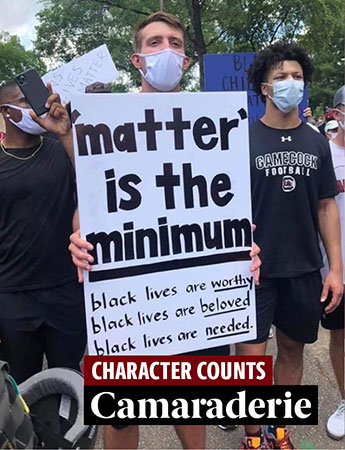
Eyes on the prizes
An MVP, a lifetime achievement award, a Nobel Prize — 2020 was a big year for high profile Gamecocks.
For starters, how about women’s basketball great A’ja Wilson? The former Gamecock forward didn’t just lead the Las Vegas Aces to the WNBA finals, she earned league MVP honors. Her success in the pros is also further testament to her time under South Carolina women’s head coach Dawn Staley — not that Staley’s program needs the attention. When the 2020 tournament was called off due to the coronavirus, the Gamecocks women’s basketball team was ranked No. 1 and on cruise control for another national championship.
Speaking of women at the top of their game, poet and English professor Nikky Finney had another banner year. In April, the winner of the 2011 National Book Award for Poetry was admitted to the prestigious American Academy of Arts and Sciences and, in September, landed the Wallace Stevens Award by the Academy of American Poets in September. The coveted lifetime achievement award came with a $100,000 prize.
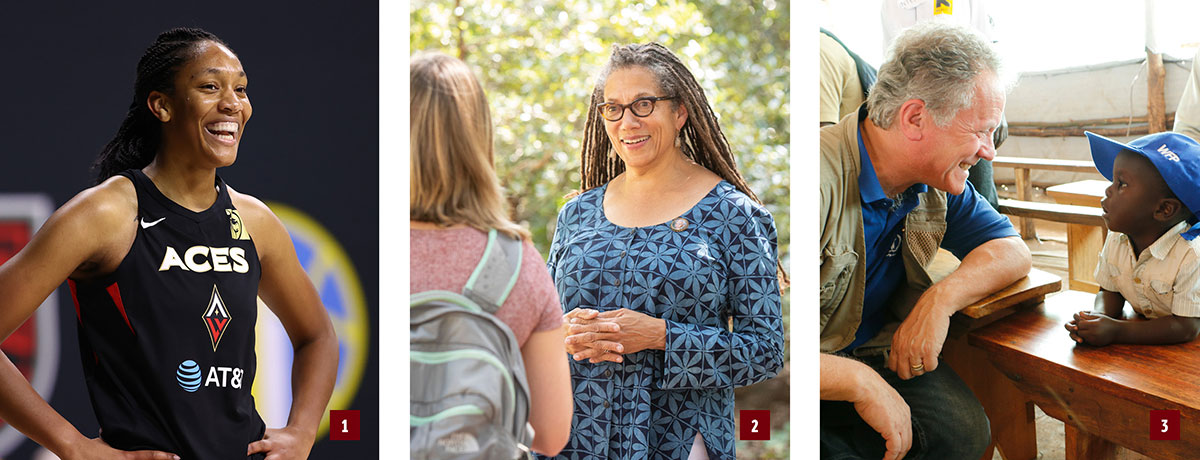
And then, of course, there was the Nobel Peace Prize awarded to the World Food Program, which is headed by alumnus and former South Carolina governor David Beasley. “The awarding of the Nobel Peace Prize to the World Food Program is a humbling, moving recognition of the work of WFP staff who lay their lives on the line every day to bring food and assistance for close to 100 million hungry children, women and men across the world,” Beasley said in an October statement. “People whose lives are often brutally torn apart by instability, insecurity and conflict.”
Of course, you don’t have to make headlines to make a difference, and achievements don’t always come with trophies, medals and prizes. The University of South Carolina Dance Marathon fundraiser, for example, raises more than a million dollars a year for Prisma Health Children’s Hospital, but the only thing the 2,000 students who participated in the February event this year brought home from the 14-hour event were memories and the satisfaction of a job well done.
“Dance Marathon is the first time that I really had to put myself out there. You have to fundraise, you have to ask people for money, which is just so uncomfortable, but I pushed through that, and it really helped me get out of my comfort zone. That’s something I will certainly use in my career. Everything else was team bonding, building spirit with a great group of people.”
Hannah Garfein, 2020 graduate, Carolinian magazine, summer 2020
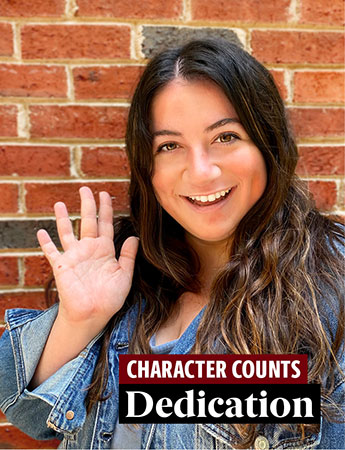
Better with age
Anniversaries and birthdays are opportunities for reflection, but how much do they really mean? Stick around long enough, and they happen. That said, every once in a while, you hit a milestone so monumental you have to strike up the band. This year, that was very literally the case.
That’s right, the Mighty Sound of the Southeast — aka the University of South Carolina Marching Band — celebrated 100 years in 2020. The band, which began as a humble outfit of 20 student musicians in 1920 now comprises more than 300, plus a dance team, plus a color guard, plus, of course, a few mesmerizing baton twirlers who never miss a beat, not even during a pandemic. To celebrate the centenary, a virtual tribute was staged on Facebook in September.
By comparison, Cocky is a spring chicken. But everybody’s favorite feathered mascot did celebrate a big one in October — his 40th. Social media birthday greetings poured in from the Gamecock cheerleaders, Alumni Association Gamecock Clubs, current students, faculty and fans On Twitter, where Cocky already enjoys significant influencer status, the hashtag #CockyTurns40 yielded plenty of memories and some truly great pics.
Elsewhere on campus, the College of Social Work continued its 50th anniversary celebration in 2020. Technically, the college hit the Big Five-Oh in 2019, but the academic year stretched into the spring and the sense of accomplishment lasted even longer. A photo mosaic of Martin Luther King Jr. designed for the college’s donor campaign was originally scheduled to be unveiled in April but was moved to October due to the pandemic.
And finally, the university celebrated the 100th anniversary of the 19th amendment and the battle for women’s suffrage with a special exhibition at McKissick Museum. “A Woman’s Right,” which opened in March, brought the women’s movement to life by exploring the lives and experiences of women on campus from the birth of the institution to today.
“When you are coming out of the magic box, the center of the field, and there are 82,000 people screaming your name, and you are the third hit of '2001.' And that football team comes out on the fourth hit and that curtain drops. It is the biggest adrenaline rush, I think, that anybody can get because the crowd goes crazy when that curtain drops on the third hit of 2001. And they're all screaming for you in the center. So, you know, it's high energy. It's probably one of the most amazing feelings you can ever get. Any time I hear 2001 now, it's still sends chills through me to this day.”
Garrett Humphries, ’01, Cocky from 1998-2001, Remembering the Days podcast
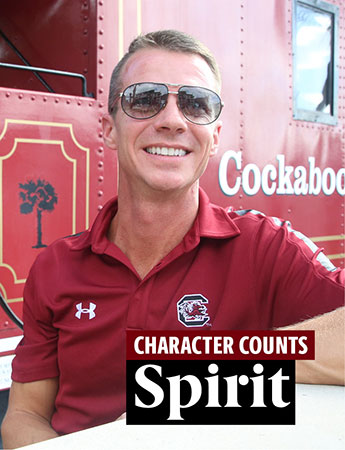
Today, tomorrow, forever to thee!
The pandemic upended a lot of plans and put some projects on hold, but that doesn’t mean the university stopped moving forward. Planned renovations progressed on schedule, new spaces opened for students and artificial intelligence got a real-world address. We even got something new to cheer about, but more on that in a minute. First, the finished business.
The overhaul of the former law school building at 1112 Greene Street was in the works long before COVID-19. In fact, the university’s new Science and Technology Building opened at the start of the spring semester, when students, faculty and staff got their first glance at the gorgeous sunlit atrium. The real attraction, though, lay beyond that grand entryway — in the new state-of-the-art chemistry instructional labs, which are expected to enhance the educational environment, attract new students and faculty and improve lab safety.
“These labs offer our students the best 21st century lab experience now available,” Lacy Ford, dean of arts and sciences, told @UofSCToday in February. “It will become a showpiece for our college and university and stands as just another example of our college’s commitment to providing an excellent undergraduate education.”
And the Science and Technology Building houses more than chemistry labs. It’s also the base of operations for the university’s new Artificial Intelligence Institute. Led by College of Engineering and Computing professor Amit Sheth, the new institute will help 10 individual colleges at the university and several major centers and research groups harness the power of big data.
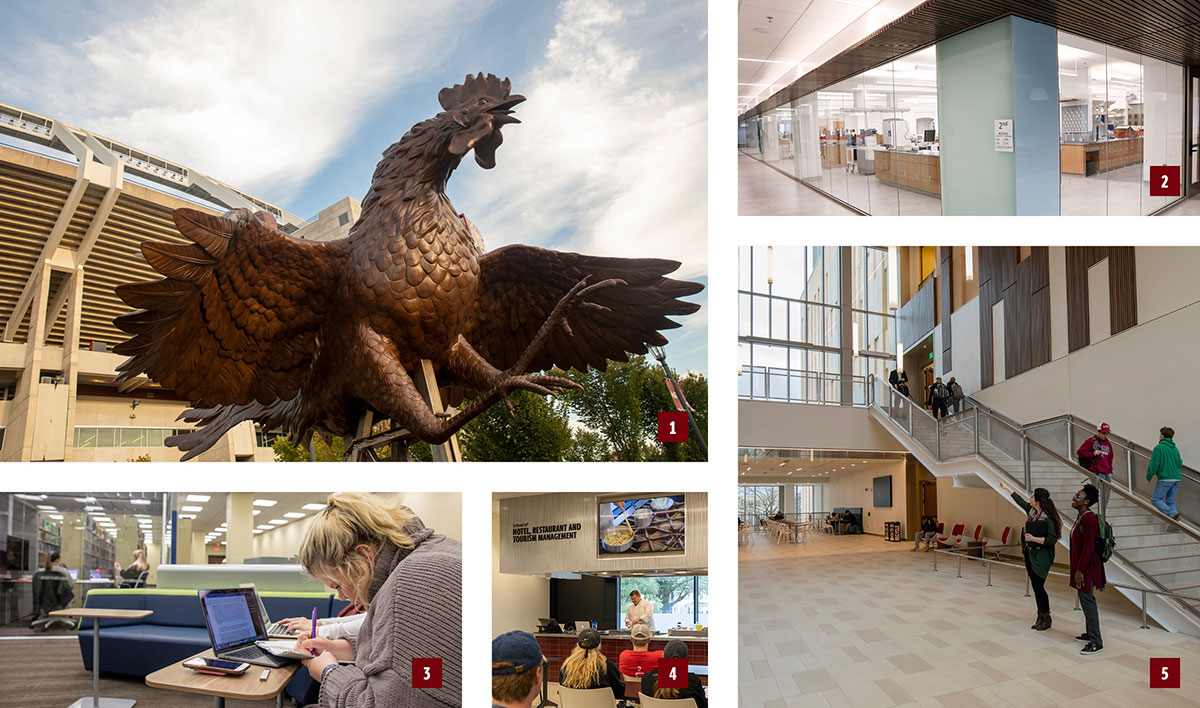
But reimagining the former law center for lab space wasn’t the only smart move this past year. Across campus, the College of Hospitality, Retail and Sport Management took over four floors of newly renovated space in the Close-Hipp Building in December 2019 and welcomed faculty, staff and students to their shiny new digs in January. The $17 million project ushered in plenty of new classroom and office space as well as a new 2,000-square-foot culinary innovation lab courtesy of the J. Willard and Alice S. Marriott Foundation.
The beginning of the spring semester also saw ribbon cuttings at Thomas Cooper Library, which unveiled new, glass-walled, tech-ready collaborative learning spaces on the fourth floor, and at South Quad, which now houses the Rhodos Makerspace, a tricked out digital workshop where today’s students can collaborate, create and launch the technologies of tomorrow.
More recently — on Veteran’s Day, no less — the university announced plans for the new Veterans and Military Center of Excellence. The 3,200-square-foot center will be housed on the first floor of the Byrnes Building, directly across from the Horseshoe, and will provide services and meeting spaces for the university’s growing military and veteran student population. Currently, there are approximately 1,300 military-affiliated students on the Columbia campus, and the plan is to increase that population by 20 percent by 2025.
Finally, something to cheer Gamecocks the world over. As students, faculty, staff and alumni made the best of an exceptionally difficult year, they were treated to something inspiring. That’s right, this fall saw the unveiling of the long-awaited Gamecock statue outside Williams-Brice Stadium. Measuring 20-feet-by-20-feet and weighing in at an impressive 10 tons, the majestic bronze bird was paid for with private funds but stands to inspire proud Gamecock faithful now and for many years to come.